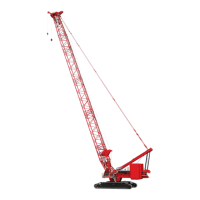Manitowoc Published 10-09-2020, Control # 259-06 8-1
MLC80A-1/MLC90A-1/MLC100A-1/MLC100-1 SERVICE/MAINTENANCE MANUAL UNDERCARRIAGE
SECTION 8
UNDERCARRIAGE
GENERAL
This section provides operational information for the Travel
System.
Additional component information for the Travel System can
be found in the following sections of this Service Manual:
• Section 2: Hydraulics
• Section 3: Electrical
This section also provides maintenance and adjustment
procedures for the crawler and turntable.
NOTE: In the following instructions, CCS stands for Crane
Control System.
HYDRAULIC TRAVEL SYSTEM
See Figure 8-2 and Figure 8-3.
Travel System Overview
The travel system consists of two open-loop hydraulic
circuits, one for each crawler. Each circuit consists of a
joystick, an engine-driven hydraulic pump, a directional
control valve, a hydraulic motor, and a disc brake.
Hydraulic Pump
The hydraulic pumps (Pump A and Main Pump B) are
electronically controlled variable-displacement type pumps.
Directional Control Valves
The directional control valves are electronically controlled
proportional valves. Each section of the directional control
valve is controlled by two solenoids. Depending on which
solenoid is energized, the valve spool moves to a position
that allows hydraulic oil from the corresponding pump to flow
to the selected travel motor for either forward or reverse
travel.
In neutral, the directional control valve spools are spring
returned to the center position. In this position, pump flow to
the travel motors is blocked and the forward and reverse
hydraulic lines to the travel motors are connected to tank.
Travel Motors
The travel motors are hydraulically pilot operated, bi-
directional, variable-displacement motors with pressure
override. The motors provide power to the planetary drive at
each crawler.
Each travel planetary drive is equipped with a spring-applied,
hydraulically-released disc brake that is controlled by a two-
position, solenoid controlled, brake valve.
The speed and direction of the travel motors depends on the
output flow volume of the travel pumps, the position of the
proportional control valves, and the position of the travel
motor servos.
Joystick Control
The pumps and proportional control valves are electronically
controlled by the position of the corresponding travel control
handle (joystick J2) and the travel speed switch located on
the right console. The joystick communicates with the crane
control system via the controller area network bus (CAN
Bus).
The left travel control handle controls pump A, the left travel
proportional control valve, and the left travel motor.
The right travel control handle controls pump B, the right
travel proportional control valve, and the right travel motor.
Travel Brake Operation
The travel brakes are a spring-applied, hydraulically-
released disc brakes located between each travel motor and
its corresponding planetary drive.
The travel brake release system uses pilot pressure from
accessory pump supplied to the travel brakes via the travel
brake solenoid valve. The brake release pressure must be at
least 22 bar (319 psi) to fully release the brakes.
If brake hydraulic pressure or electrical control is lost, the
travel brakes are applied by spring force.
Travel Park Brake Released
In the UN-PARK position, the travel park switch is closed,
causing the switch to send 24 V
DC
back to the joystick (J2).
When 24 V
DC
is detected, joystick J2 activates the travel
control handles, but does not allow the travel brakes to
release until one or both travel control handles are moved.
When a travel control handle is moved in either direction, it
sends a release brake command to the CCS. The CCS then
sends 24 V
DC
to the travel brake solenoid valve. This causes
the travel brake solenoid valve to open, allowing hydraulic oil
to flow to the travel brakes. The increased pressure releases
the travel brakes.
Travel Park Brake Engaged
In the PARK position, the travel park switch is open, causing
the switch to send 0 V
DC
back to the joystick (J2). When
0V
DC
is detected, joystick (J2) deactivates the travel control
handles and sends an apply brake command to the CCS.
This causes the travel brake solenoid valve to close, allowing
the hydraulic oil in the brake system to flow back to the tank.

